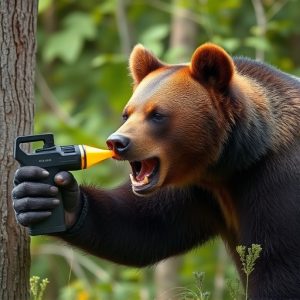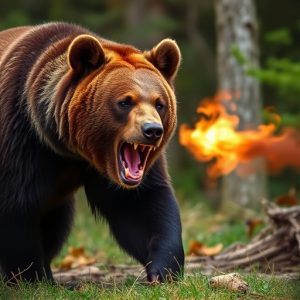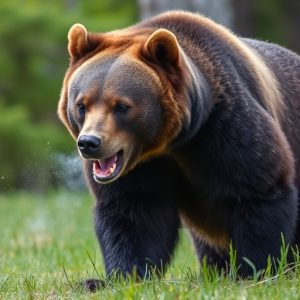Unraveling Bear Spray’s 30-Foot Effectiveness: Strategies for Safe Outdoor Adventures
Understanding the best bear spray distance pattern (around 30 feet) is crucial for safe navigation i…….
Understanding the best bear spray distance pattern (around 30 feet) is crucial for safe navigation in bear country, as it considers reaction time and deterrence likelihood. Factors like wind speed, terrain, spray angle, and bear behavior can affect actual reach, making strategic positioning, timely activation, and regular practice key to maximizing safety during encounters.
“Unraveling the mystery of bear spray’s effective range—is the thirty-foot claim all it seems? This article breaks down the science behind bear spray distance, offering a comprehensive guide for outdoor enthusiasts. We explore how factors like wind, terrain, and bear behavior can impact your protection. Learn essential strategies to maximize safety within the stated range, ensuring you’re prepared when encountering these majestic yet potentially dangerous creatures. Discover the best practices for optimal bear spray usage and stay secure in the wild.”
- Understanding Bear Spray Effective Range: What Does ‘Thirty Feet’ Mean?
- Factors Influencing Bear Spray Distance: Beyond the Face Value
- Maximizing Your Safety: Strategies for Optimal Bear Spray Usage within the Thirty-Foot Range
Understanding Bear Spray Effective Range: What Does ‘Thirty Feet’ Mean?
When considering bear spray, understanding its effective range is crucial for safety in bear country. The term ‘thirty feet’ refers to the optimal distance at which the spray can be effectively deployed against a bear. This range is not merely a measurement of how far the spray reaches but also the time it takes for the bear to react and the likelihood of deterring an attack. In terms of the best bear spray distance pattern, this thirty-foot range offers a window during which users can aim and deploy the spray, maximizing its effectiveness.
The ‘thirty feet’ is not a strict boundary but rather a general guideline based on research and testing. The actual effective range can vary depending on several factors: wind speed and direction, terrain, the angle of the spray can, and even the specific bear behavior. For instance, in open areas with light winds, the range could potentially extend further than thirty feet. Conversely, in dense foliage or against a headwind, the range may be shorter. Understanding these variables helps users anticipate and adapt to different situations while ensuring they have the best chance of staying safe during encounters with bears.
Factors Influencing Bear Spray Distance: Beyond the Face Value
The stated effective range of bear spray, thirty feet, is a widely accepted standard—but what factors can influence this distance beyond the face value? It’s important to understand that the best bear spray distance pattern isn’t solely determined by the product’s specifications. Wind conditions play a significant role; a gusty day could reduce the reach of the spray, while a calm one might allow for a slightly longer effective range.
Terrain also matters. In an open field, the spray could travel farther than thirty feet, but in a dense forest with tall trees and underbrush, the distance may be significantly shorter. The angle at which the spray is directed and the presence of obstacles can also affect its trajectory and ultimate reach. These factors underscore that while thirty feet is a reliable estimate for optimal conditions, real-world scenarios can vary widely.
Maximizing Your Safety: Strategies for Optimal Bear Spray Usage within the Thirty-Foot Range
Maximizing Your Safety: Strategies for Optimal Bear Spray Usage within the Thirty-Foot Range
When it comes to bear spray, understanding the best distance pattern is key to your safety in the wild. The optimal effective range of bear spray is indeed around thirty feet, but maximizing its effectiveness requires strategic use. One crucial tip is to ensure proper positioning; stand side-on to the bear and point the spray directly at its face and eyes. This approach not only increases the likelihood of a direct hit but also minimizes the risk of wind blowing the spray away from the target.
Additionally, timing is critical. Activate the spray when the bear is within thirty feet and approaching aggressively. The goal is to create a barrier of capsaicin in the bear’s face, temporarily blinding and disorienting it, allowing you time to retreat or defend yourself further. Remember, practice using your bear spray beforehand so that you’re comfortable with its operation in case of an actual encounter, ensuring every second within that thirty-foot range counts.
Understanding the best bear spray distance pattern is crucial for maximizing safety in potential encounters. While the manufacturer’s stated effective range of thirty feet is a good starting point, various factors can influence this distance. By being aware of these variables and employing strategies to ensure optimal usage within the thirty-foot range, individuals can significantly enhance their chances of deterring bears effectively. Remember that proper usage techniques and knowledge of local bear behavior are key to staying safe in bear country.


